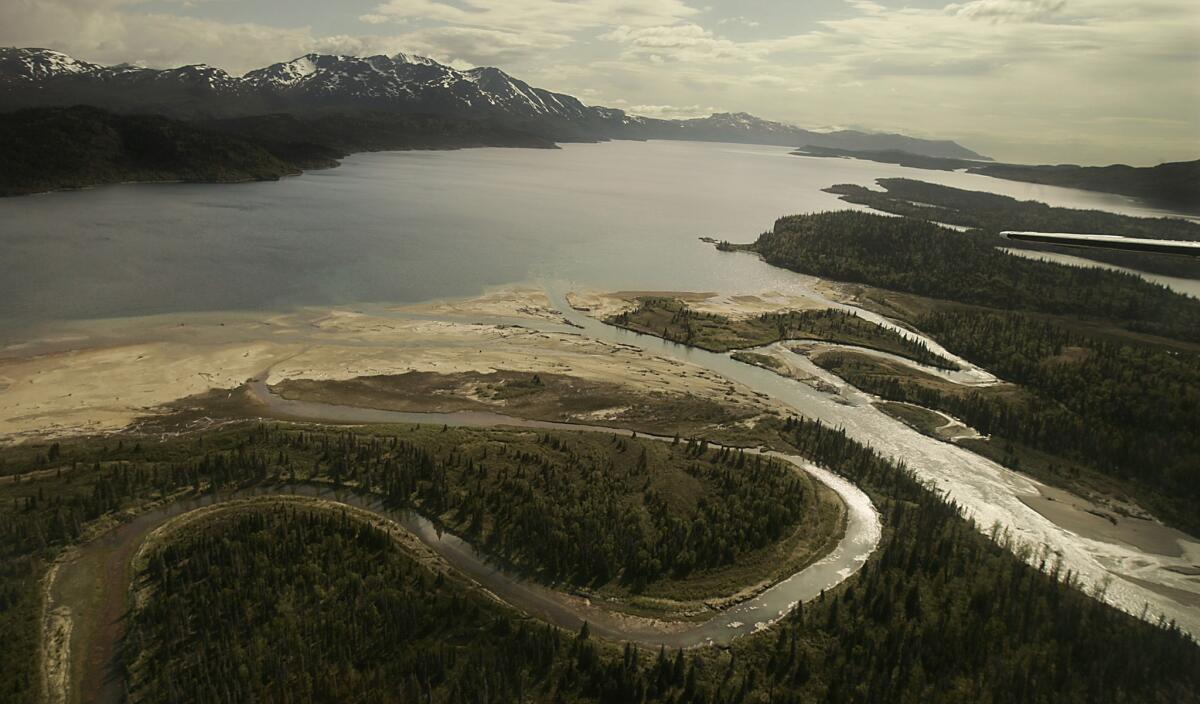EPA’s proposed limits pose roadblock for Alaska’s Bristol Bay mine

- Share via
REPORTING FROM SEATTLE — The Obama administration proposed mining restrictions in Alaska on Friday that would protect what the U.S. Environmental Protection Agency described as “one of the world’s most valuable salmon fisheries,” but which critics said could effectively halt development of one of the largest open pit mines on the planet.
EPA officials said they would prohibit any discharges or dredging from the planned Pebble Mine above Alaska’s pristine Bristol Bay that would result in significant destruction or alteration of salmon-bearing streams, wetlands, lakes and ponds.
Plans for mining copper, gold and molybdenum by the Pebble Limited Partnership call for an open pit operation nearly as deep as the Grand Canyon that would result in “excavation of almost unfathomable amounts of rock,” EPA Region 10 Administrator Dennis McLerran told reporters.
Even the most limited version of the project studied by the federal agency would dig up enough matter “to fill one of the largest professional football stadiums more than 880 times,” McLerran said Friday. “Quality salmon habitat is at a premium, and we can ill afford to lose so much of it at the headwaters of our greatest remaining fishery.”
Pebble Mine’s low-grade deposits are located at the headwaters of the Bristol Bay fishery and next to a
national park. Allowing the mine to go forward has
been a politically fraught proposition, a faceoff among the state’s biggest industries — mining, fishing and tourism.
Sen. Lisa Murkowski (R-Alaska) said it was misleading to suggest the agency’s proposal “is only going to impact mining in a particular area of Alaska.”
“The EPA is setting a precedent that strips Alaska and all Alaskans of the ability to make decisions on how to develop a healthy economy on their lands,” Murkowski said in a written statement. “This is a blueprint that will be used across the country to stop economic development.”
McLerran said the proposal was not a veto of mining in the region, whose salmon fishery supplies nearly half of the world’s wild sockeye salmon. The multiplier effect of harvesting, processing and retailing Bristol Bay salmon is worth $1.5 billion across the country, according to a University of Alaska-Anchorage study.
The agency said it was authorized by the federal Clean Water Act to prohibit or restrict any operation that would place dredged or fill material into the nation’s waterways. Among other restrictions, the EPA on Friday proposed limiting all dredged or fill material that would destroy “five or more miles of stream with documented salmon occurrence” in the Bristol Bay region.
Alaska natives, environmentalists, hunters and fishermen applauded the proposal, which faces a month of public hearings in Alaska before the agency makes a final decision.
Daniel Cheyette, associate general counsel for the Bristol Bay Native Corp., said his organization and the 9,600 Alaska Natives for whom it advocates are “thankful to the EPA for moving forward with the process to review Pebble Mine and assess the impacts it would have on the Bristol Bay region.”
Cheyette said the group wanted federal regulations that would “be sufficient to protect the Bristol Bay region, the salmon fisheries and the people who rely on them.” The corporation operates mines among other enterprises but views all development, he said, through a “fish-first perspective.”
Chris Wood, president of Trout Unlimited, called the EPA’s announcement “hugely significant” and noted that digging a mine the size of those described by the company in filings with the Securities and Exchange Commission would require “industrializing a landscape that is today one of the most pristine places on Earth.”
But to some mining industry officials, the EPA’s proposal amounts to a veto of excavation in the region. Pebble is a potential source of millions of dollars’ worth of minerals, and mining could bring hundreds of jobs to the struggling area.
“The restrictions that EPA placed on any mining activity in the region is a de facto ban on a mine,” said Luke Popovich, spokesman for the National Mining Assn. “Short of a veto, they have cleverly — they think — used a different means of blocking mining development in that watershed.... I think it’s, frankly, deceitful.”
Pebble Partnership Chief Executive Tom Collier said he and his firm were “outraged” the EPA announced the plan while the issue is pending in court, and he vowed that they would continue fighting the agency.
The company has yet to apply for a permit or submit a detailed development plan, he said in a written statement, noting that “we believe that EPA does not have the statutory authority to impose conditions on development at Pebble” or anywhere else preemptively.
The controversy over the EPA’s recommendation underscores the deep hostility many elected officials in Alaska feel toward a federal agency that many here argue tramples states’ rights.
“The EPA’s expansive, jurisdictional power grab is a very serious threat to Alaska’s sovereignty and the future of any development on state, Alaska Native or privately owned lands both in Alaska and across the United States,” said U.S. Rep. Don Young, a Republican.
maria.laganga@latimes.com
@marialaganga
More to Read
Sign up for Essential California
The most important California stories and recommendations in your inbox every morning.
You may occasionally receive promotional content from the Los Angeles Times.














